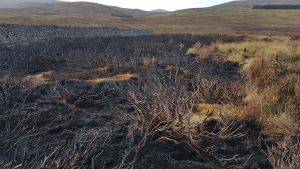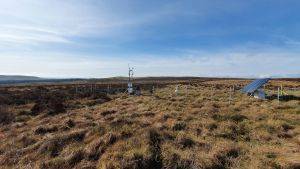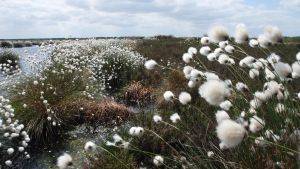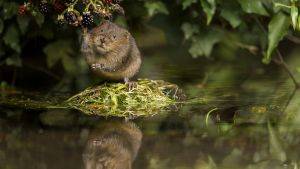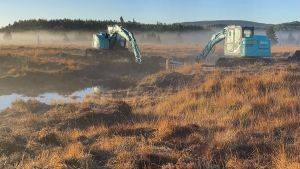Evidence Review on Burning
We welcome the publication, this week (31/03/2025), from Natural England (NE): ‘An evidence review update on the effects of managed burning on upland peatland biodiversity, carbon and water’ NEER155). The first Natural England evidence review (Review of Upland Evidence NEER004) was published in 2013, and there have been several significant studies published in the intervening period.
The IUCN UK Peatland Programme have now updated our Position Statement on ‘Burning and Peatlands’ to version 5 considering this significant publication.
The findings of this review (NEER155) have led to UK government setting out ‘new proposals to ban heather burning on peatland to protect air, water and wildlife’. The proposals to ban burning on peatland will be put to a consultation which will run for eight weeks from today and the public and land managers are urged to have their say.
Respond to the consultation here: Heather and Grass Burning in England - Defra - Citizen Space.
Our summary of key points from the Evidence Review:
- Since the publication of the previous evidence review in 2013 (The effects of managed burning on upland peatland biodiversity, carbon and water - NEER004) there have been a significant increase in the number of publications related to the subject. The review adds 102 papers to the 123 in NEER004.
- The review highlights that a considerable proportion of evidence is derived from a relatively small number of geographic locations and therefore the conclusions are most relevant to northern England and Scotland.
- Overall, while evidence in some areas is inconsistent, the findings of NEER155 are, in the main, consistent with those of the previous review.
- There are 93 evidence points in the review answering eight sub questions and we provide a summary of a few points of interest here. For a full exposition we would direct readers to page 193 of the evidence review:
- While vegetation and structure recover these can be over variable timeframes from months to decades. There is an initial increase in graminoid dominance over 10-20 years post burning, followed by increased Calluna dominance. This transition to Calluna occurred faster on drier sites.
- There has been an increased amount of evidence around the response of fauna. Mountain hare numbers have been found to increase on restored sites compared to managed burning sites. Adders were found to prefer unburned sites from a survey in Scotland. Effects on birds are variable, and the review highlights the difficulty of disaggregating the effects of burning and predator control in particular. However, curlew and lapwing numbers were found to be greater on bog-vegetation plots compared to Calluna dominated plots.
- Carbon balance is impacted by managed burning, with studies showing consistent impacts on above and below ground carbon storage. Evidence also found that regularly burned and cut plots increased GHG emissions, compared to plots which were no longer burned, which acted as sinks.
- Moderate evidence for Calluna and tree/scrub dominated sites suffering more severe wildfires and moderate evidence that severity of wildfire is decreased on wetter sites (either naturally wetter sites or restored and rewetted). Evidence for the occurrence of greater area(s) of bare peat post wildfire in areas subject to recent prescribed burning.
- Evidence for the use of fire or mechanical treatment for controlling wildfire from the UK (ignition, severity, behaviour or extent) is weak. There is strong but sometimes contradictory evidence around the use mechanical treatments and prescribed burning from south Europe, Australia and north America. However, it also highlights that these systems may not be comparable to UK systems as they are dry forested systems.
- Vegetation composition was found to impact dissolved organic carbon (DOC) treatability. DOC derived from Calluna is more problematic to remove at the point of water treatment for drinking water than that derived from other vegetation types.
The report concludes:
“The combined evidence from NEER004 and the update suggests that burning can affect peatlands, and the ecosystem services they provide relating to biodiversity, carbon and water, with numerous potential pathways for influence. Key changes such as altered vegetation composition and structure recover on varying timescales, ranging from months to decades. Repeated burning risks interrupting the trajectory of recovery, resulting in a sustained departure from characteristic peatland structure and function. Furthermore, UK peatlands where burning occurs are often degraded due to past and current stressors including fire, suboptimal grazing and atmospheric pollution, and continued burning may inhibit recovery or restoration.”
Changes to the assessment of blanket bog and heathland habitats
In addition to the NE evidence review, there are two further documents which have been released:
- Definition of Favourable Conservation Status for Heathland - RP2977
- Definition of Favourable Conservation Status for Blanket bog - RP2967
Both documents outline the definitions and approaches used to assess the condition of blanket peatland and shallow peat heathlands. Favourable Conservation Status (FCS) defines the minimum threshold where habitats and species can be considered to be thriving. Here we provide a summary outlining the key messages from the review and the FCS documents.
A background on Favourable Conservation Status (FCS)
With the FCS documents for both heath and blanket bog, Natural England lay out the approach they will take to assessing the effectiveness of conservation and restoration of these habitats in England. The documents both adhere to the foundational principles which were outlined in Defining Favourable Conservation Status in England - EIN062. They are holistic in outlook, recognising the interconnectedness of the upland mosaic. Fundamentally, they recognise importance of small transitional and boundary habitats such as spring seepage, upland alkaline fens, and flushes to the ecological and hydrological integrity of the habitats. The documents highlight the degraded state of blanket peatlands and extensive loss of shallow peat wet heaths. The publication of these documents is a call to action to halt and reverse further declines to the broad mosaic of peatland habitats and future funding commitments will be needed to ensure that the targets outlined in them can be met.
Favourable conservation status on blanket bog: our summary
- Blanket peatlands in the UK are currently not in favourable conservation status overall. Only 11% of England’s blanket bog is in favourable condition within SSSI’s. This figure is slightly higher than the 9% we quoted in the 5-year UK Peatland Strategy Progress Report published in 2024.
- Human activity is the predominant driver of degradation and factors are both intrinsic (e.g. drainage, grazing and burning) and extrinsic (e.g. atmospheric deposition of pollutants). Distribution of blanket bog has largely remained stable even where damage is severe. However, forestry has been a major driver of loss, with the largest single area of loss being Kielder Forest at around 25,000 ha.
- Changes are proposed to the depth threshold at which deep peat is classified from 40 cm down to 30 cm, this would bring significantly more peat under protection. However, while we understand the rationale outlined in the FCS that plants are generally able to reach nutrients below the peat at depths below 30 cm, our view is that a threshold of 30cm is still not sufficiently scientifically grounded, and even within the FCS document it is acknowledged that blanket bog may occur on peat depths shallower than 30 cm.
- It also recognises the importance of a range of complementary – yet often overlooked – habitats and the importance of these in the upland mosaic, including springs, flushes, alkaline fens, and heath. The FCS highlights the role that these habitats play in supporting the hydrological integrity of the peat and acting as refugia for species.
- The unique ‘tope’ structure (i.e. the physical microtopography of the peatland surface vegetation) is emphasised as vital to functioning. The loss of much of this from England’s peatlands is highlighted throughout. Although of concern, it is not included in the structural attributes table (Table 2).
- The report also restates the findings of a previous evidence review on restoration (NEER003) that there is no evidence that any area is unrestorable where conditions are right to support establishment and recovery of bog species.
Favourable conservation status on heathland: our summary
- The FCS covers lowland and upland heath but excludes montane and alpine heath (those occurring above 600 m).
- Similarly to blanket peatlands in the UK heathlands are currently in unfavourable condition. A figure for SSSI’s is not given.
- The extent of heathland has declined by 70-80% over the past 300-400 years as a result of conversion to agricultural land and development. To reverse the historic loses, an extent increase of 135,000 ha to 417,000 ha is required. Wet heath should form a substantial proportion of this increase (106,000 ha) with the remainder being dry heath.
- Across the uplands the status of heath sites is poor due to drainage, vegetation management and nutrient enrichment resulting from atmospheric deposition.
- In recognition of the fact that dry heath vegetation has likely replaced the mire vegetation that should be found on many sites, where deep peat (above 30 cm) is present the site should be classified as degraded mire habitat rather than heath habitat. This means that sites are not classified based on the surface vegetation alone but take into account peat depth.
- The FCS highlights that fire is not regarded as a natural process within the UK and these systems are not fire dependent.
- Where peat or peaty pockets are present at depths of between 10-30 cm these areas should be classified as wet heath rather than dry heath, and the aim should be to restore these areas to this habitat.
- The FCS acknowledges the challenges and unknowns around rewetting shallow peat soils due to a poor understanding of the underlying biogeochemical processes. To meet the expansion target outlined above it is therefore likely that further research funding will be required to support these plans, in addition to long term funding for ongoing maintenance of the habitat.

